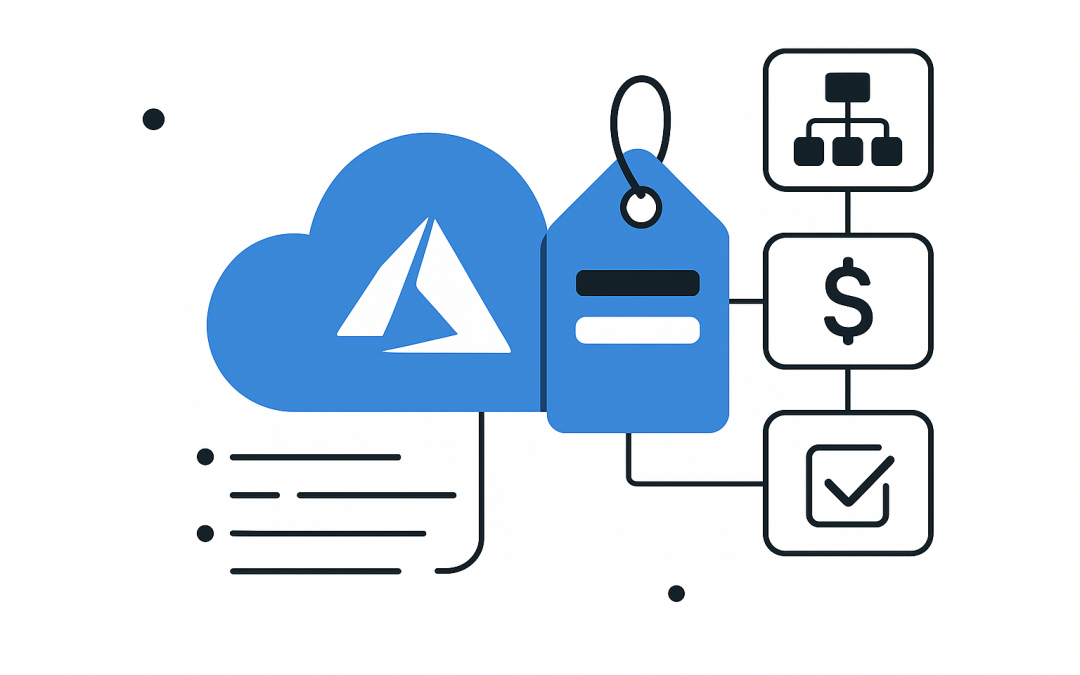This Azure post “Implementing Tags in Azure – Best Practices” will explain how to use Azure Tags effectively.
As organizations grow their cloud footprint in Microsoft Azure, managing resources efficiently becomes essential. Tags in Azure are one of the simplest yet most powerful tools available to improve governance, cost control, and operational efficiency. By applying tags consistently, enterprises can categorize resources, enforce policies, and optimize their cloud strategy.
In this post, we’ll explore how to implement tags in Azure, the best practices for using them effectively, and provide examples and patterns you can adopt to standardize your tagging strategy.
What Are Azure Tags?
Tags in Azure are key-value pairs that help you logically organize resources. Unlike resource groups, which provide a structural grouping, tags allow you to apply custom metadata across subscriptions, resource groups, and individual resources.
Example:
{
"Environment": "Production",
"Department": "Finance",
"CostCenter": "CC1001"
}
These tags can then be used for:
- Billing and cost allocation (e.g., identifying which department incurs cloud costs).
- Operational management (e.g., filtering resources by environment).
- Automation and governance (e.g., applying policies based on tags).
How to Implement Tags in Azure
Azure provides several ways to implement tags, depending on scale and requirements:
1. Azure Portal
Manually add tags when creating or editing a resource. This is suitable for small deployments but inefficient at scale.
2. Azure PowerShell
You can script tagging to ensure consistency.
# Add a tag to a resource
New-AzTag -ResourceId "/subscriptions/{subId}/resourceGroups/ProdRG/providers/Microsoft.Compute/virtualMachines/VM01" `
-Tag @{ "Environment"="Production"; "Owner"="ITOps" }
3. Azure CLI
# Add or update a tag
az resource tag \
--ids /subscriptions/{subId}/resourceGroups/ProdRG/providers/Microsoft.Compute/virtualMachines/VM01 \
--tags Environment=Production Owner=ITOps
4. ARM Templates & Bicep
You can enforce tags during provisioning.
resource vm 'Microsoft.Compute/virtualMachines@2023-09-01' = {
name: 'ProdVM01'
location: 'eastus'
tags: {
Environment: 'Production'
Owner: 'ITOps'
}
}
5. Azure Policy
Azure Policy ensures compliance by enforcing tagging rules automatically. For example, you can:
- Require a tag on all resources.
- Append a tag if missing.
- Inherit tags from the resource group.
Example Policy Snippet:
{
"if": {
"field": "tags['Environment']",
"equals": null
},
"then": {
"effect": "modify",
"details": {
"operations": [
{
"operation": "addOrReplace",
"field": "tags['Environment']",
"value": "Production"
}
]
}
}
}
Best Practices for Azure Tagging
While implementing tags is straightforward, the challenge lies in standardizing them across the organization. Here are some best practices:
1. Define a Tagging Taxonomy
Agree on a standard set of tags for the organization. Common tags include:
- Environment:
Production,Staging,Development - Department:
Finance,HR,Marketing - CostCenter:
CC1001,CC2002 - Owner:
John.Doe@company.com - Application:
CRM,ERP,DataLake
This ensures consistency across teams.
2. Limit the Number of Tags
Although Azure supports up to 50 tags per resource, too many tags create complexity. Focus on the minimum set needed for cost allocation, governance, and operations.
3. Enforce with Azure Policy
Don’t rely on manual tagging. Use Azure Policy to enforce mandatory tags and prevent deployment of non-compliant resources.
4. Use Automation
Automate tagging via ARM templates, Bicep, or Infrastructure-as-Code (IaC) pipelines. This reduces human error and ensures tags are applied at deployment time.
5. Audit and Report
Leverage Azure Resource Graph or Cost Management + Billing to query and report on tags. This helps detect missing or inconsistent tags.
Example Query (Resource Graph):
Resources
| project name, type, tags
| where isnull(tags['Environment'])
This query finds resources missing the Environment tag.
6. Avoid Free-Text Inputs
Standardize tag values to avoid inconsistencies. For example:
- Good:
Environment=Production - Bad:
Environment=Prod,environment=production,Env=PROD
Instead, define a controlled vocabulary and share it with all teams.
7. Plan for Tag Inheritance
Decide whether tags should be inherited from resource groups or applied directly to resources. Inheritance simplifies management but may reduce flexibility.
Tagging Patterns and Examples
Here are some patterns you can adopt depending on organizational needs:
Cost Allocation Pattern
{
"CostCenter": "CC1001",
"Department": "Finance"
}
This ensures all costs can be traced back to a financial unit.
Operational Pattern
{
"Environment": "Production",
"Owner": "ITOps",
"Application": "CRM"
}
Helps quickly identify resource purpose and ownership.
Security & Compliance Pattern
{
"DataClassification": "Confidential",
"Compliance": "ISO27001"
}
Useful in regulated industries to manage sensitive data.
Common Mistakes to Avoid
- Inconsistent Tag Keys: Mixing
Ownerandownerleads to fragmented reporting. - Over-Tagging: Applying too many tags reduces clarity.
- Lack of Enforcement: Manual tagging without policies results in gaps.
- Not Updating Tags: Tags must evolve with resource lifecycle changes.
Conclusion
Tags in Azure may look simple, but when implemented properly, they become a powerful foundation for governance, cost control, and automation. By defining a clear taxonomy, enforcing policies, and auditing regularly, organizations can gain better visibility and control over their cloud estate.
The key takeaway: Treat tags as first-class citizens in your cloud strategy. Done right, they not only improve compliance and accountability but also save time, reduce costs, and simplify management at scale.
Table of contents
Discover more from CPI Consulting -Specialist Azure Consultancy
Subscribe to get the latest posts sent to your email.

